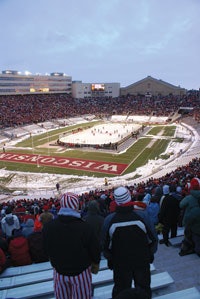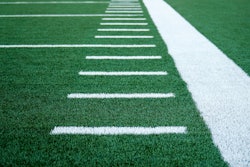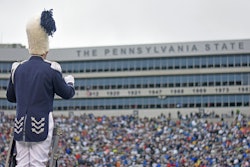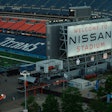As the popularity of stadium ice hockey solidifies, staging events remains a delicate balance of nature versus nurture.
 WINTER 'CAMP' February hockey could be accommodated in the University of Wisconsin's football venue only after pipes were insulated and restrooms brought back online.
WINTER 'CAMP' February hockey could be accommodated in the University of Wisconsin's football venue only after pipes were insulated and restrooms brought back online.The University of Michigan men's hockey team took to the ice and immediately began whooping it up. "They were yippin' and yappin'," says Mike Stevenson, the university's executive associate director of athletics. "You could just tell it was a different atmosphere, and they were having a hell of a lot of fun."
This, at a Michigan practice in Madison, Wis. - inside the University of Wisconsin's home football venue, and as outside as any of these players had been in their competitive careers. So they took advantage, circling and chirping in full gear and subfreezing temperatures.
"There is no other feeling like [hearing] the sound the puck makes when it leaves your stick or the sound that your skate makes when it cuts on outdoor ice," Wisconsin coach Mike Eaves told a campus newspaper in the run-up to the Feb. 6 Culver's Camp Randall Hockey Classic, the mere concept of which sounded good enough to more than 55,000 fans who braved temperatures falling through the 20s to see the Badgers win their second outdoor game in four years. (In February 2006, Wisconsin defeated Ohio State in the Frozen Tundra Hockey Classic in front of 40,890 spectators gathered at one end of Green Bay's Lambeau Field.)
Still offering that "different atmosphere," stadium ice hockey has over the past decade become more ubiquitous than unique. Since Michigan State University drew a world record hockey crowd of 74,544 to Spartan Stadium in October 2001 to witness the so-called Cold War against Michigan (played to a 3-3 stalemate), North American teams north of the 41st parallel have taken the game outside.
The National Hockey League got in the act in November 2003, and for three years running has staged the Winter Classic on New Year's Day. Sites have stretched from Edmonton's Commonwealth Stadium to as far south as Chicago's Wrigley Field. This year's matchup between Philadelphia and Boston was the first of three outdoor hockey games played within a week at Fenway Park. On Jan. 8, a women's college game between New Hampshire and Northeastern preceded a men's game pitting Boston University against Boston College (the intercity rivalry drew 38,472 fans, 360 more than attended the NHL contest seven days earlier). After the Camp Randall Hockey Classic, which also featured the Badger women hosting Bemidji State in a matinee, the boards, glass and ice-making equipment were trucked from Madison to Syracuse, N.Y., for an American League Hockey game at the New York State Fairgrounds. There, an AHL-record crowd of 21,508 saw the hometown Crunch face not only visiting Binghamton, but gusty winds and occasional snow flurries, too.
"The hockey people will tell you that this is going back to the past. This is where hockey was always played - outdoors," says Stevenson, adding that the Wolverines will wear throwback 1940s jerseys Dec. 11 when they welcome Michigan State to 106,000-seat Michigan Stadium for The Big Chill at the Big House. "There's just a lot fun about it. For the spectators, the players and the coaches, it's exciting. I don't mean it isn't fun for the administrators, but there are so many details that you really worry about that are not in your control. You just hope everything works out right."
That admitted leeriness explains Stevenson's scouting mission to Madison, where he made mental notes of Wisconsin's operational game plan during the Camp Randall Classic. And he hasn't for a second forgotten the Cold War, which was threatened by 70-degree weather a mere four days before the Oct. 6 faceoff in East Lansing nine years ago.
Greg Ianni remembers it better than anyone. "The worst part was we had high winds coming out of the south," says Michigan State's senior associate athletic director for facilities and sports management. "So the ice we had made the night before was turning into water, and the water started leaking out under the boards."
 'FAIR' WEATHER FANS A record American Hockey League crowd of 21,508 packed the New York State Fairgrounds in Syracuse to watch the hometown Crunch host Binghamton in February.
'FAIR' WEATHER FANS A record American Hockey League crowd of 21,508 packed the New York State Fairgrounds in Syracuse to watch the hometown Crunch host Binghamton in February.At that point, ice-making expert Dan Craig, on loan from the NHL, pulled Ianni aside. "He said, 'Look, if the temperature doesn't drop tonight, this thing's off. There's no way you can make ice in time.'" As luck would have it, temperatures dropped (into the 30s and 40s) and, ultimately, so did the puck. "We were fortunate," Ianni says. "Very fortunate."
Why did Michigan State even tempt fate with an early fall playing date? "It's when it fit into our football schedule the best, and we didn't want to deal with the issues that any other northern venue deals with when you're playing in December and January," says Ianni. "Clearing snow out of the stadium becomes really labor intensive, and we really didn't want to go there. We just thought that we could get it done."
The refrigeration system that rose to the occasion consisted of interlocking aluminum panels laid atop an adjustable stage erected to take the crown out of Spartan Stadium's synthetic turf field. Glycol was pumped through channels inside the aluminum panels from a chiller set up on the outskirts of the stadium footprint. That location, which has become commonplace in stadium hockey settings, places the chiller within reach of a stadium's power sources and keeps a noisy eyesore off the field. Still, depending on where a rink is fed refrigerant - at one end or near the center line - this can translate to long runs of several hundred feet, and extra pumps. "One of the bigger challenges we had was the run on the glycol, which was right at the edge of being too long from the refrigeration unit to the ice and back, and keeping the temperature in the glycol where we needed it," Ianni says.
"You want to avoid a long run, but that doesn't mean that a long run makes your event impossible," says Patrick Seltsam, project manager for stadium events at Houston-based Ice Rink Events, which built the rink in Madison and is contracted to do likewise in Ann Arbor. "Michigan is going to be a side feed, so even though the tunnel is a lot longer at Michigan, the distance from the chiller to midfield, because it's coming into the middle of the rink instead of one of the ends, is actually shorter."
The aluminum panel system, which the NHL has chosen for its in-house construction of outdoor rinks, is just one option. Another, less expensive way to make ice (and the one preferred by Ice Rink Events) employs rolls of flexible tubing on the rink floor. "Our main competitor is feasibility," Seltsam says. "We need to make sure that we price what we do in such a way that the event is feasible."
A big expense in Madison - and a major staging breakthrough, according to Seltsam - was the introduction of DuraFill® geofoam to neutralize the field's crown. The high-density material, custom cut by SGASi Production Services to a thickness ranging from 2 to 8 inches, was laid on top of tongue-and-groove engineered wood, then covered in a 2-inch layer of higher-density geofoam and another layer of wood. Finally, a vapor barrier blanketed the wood before the tubing was rolled out. "The platform is the most challenging piece - getting a solid, level platform that can handle the weight of 10,000 pounds worth of ice resurfacing machine," Seltsam says. "You have to have zero or extremely close to zero deflection, and your tolerances for level have to be well under a half-inch."
Making ice, Seltsam says, is the easy part - provided the weather cooperates and the process isn't rushed. During the three- to four-day effort (ideally), layers of ice are built and marked just as with an indoor rink. A key consideration outdoors, however, is the darkness of lines and logos. In fact, Seltsam recommends forgoing superfluous logos altogether. "You don't want to have dark spots on the ice because they will attract sunlight, and then you'll have soft spots," he says, adding that he would like to work with future clients on strategies to minimize the heat-gathering impact of game lines, too. "Maybe instead of having a solid blue line, you have an outline of the blue line."
Naturally, an event named The Big Chill at The Big House has a logo to go with it, and Stevenson would like to see some graphics on the ice during Michigan's game, which is scheduled to start at 3 p.m. "One of the options we're looking into is whether we can project that logo on the ice from some type of a light system and not have it actually in the ice," he says.
However it is dressed up, a finished outdoor ice sheet goes through a maturation process, and this, too, can take days. Everything that comes in contact with that initial, flawless sheet - from resurfacing machines to individual skaters - will fracture it, and each subsequent flood strengthens it. Something that caught Stevenson by surprise during his site visit to Madison involved the UW's decision to rent two ice-resurfacing machines rather than risk damage to the Kohl Center's units during an eight-block trek through campus. Michigan will follow Wisconsin's lead only so far, Stevenson says: "We're probably going to lease one machine and take one of ours from Yost Ice Arena" over to Michigan Stadium. In 2006, Michigan State opted to resurface its rink at Spartan Stadium using only one university-owned machine. "We didn't use our A machine in there, but we have another one that's a little older and a little smaller, and it wasn't as heavy, which worked perfect to resurface the ice," Ianni says. "It took a little longer to resurface it, but we made that accommodation."
 ICE BOWL With the rink situated in one end of Lambeau Field, fans attending the Frozen Tundra Classic in 2006 were treated to optimal sightlines.
ICE BOWL With the rink situated in one end of Lambeau Field, fans attending the Frozen Tundra Classic in 2006 were treated to optimal sightlines.Patience is critical, according to Seltsam. "Completing the ice and saying, 'Okay, it's ready for the first skater,' doesn't mean it's ready for a game," he says. "That means it's ready to begin being seasoned, it's ready to begin having a life of its own. The more skating you can do on a rink before your major event, the better. It's not like it's better when it's pristine and new. It's better when it has been used for a while."
And the longer it is used, the more economic sense a temporary rink makes, according to Seltsam (see "A New Ice Age," below). "A lot of the attention has been directed toward this concept of getting it in and out in one week for a major event," he says. "The important thing to bear in mind is that the main expense for putting this rink in is putting the rink in. If clients can have that rink in for a month, the revenue generation potential is fabulous. They're paying several hundred thousand dollars for the first minute of ice, and they're paying 50 cents for the next minute. They need more of those 50-cent minutes to leverage that install cost."
Any outdoor installation, particularly one tied to a major event, carries with it some financial risk. "It seems crazy to think you have to go through all these steps to ensure you have frozen ice in Madison in February, but who knows? It could be 40 degrees once every 20 years, and then you're really in trouble," says John Jentz, Wisconsin's associate athletic director for business operations. "From my perspective, the really frightening aspect of this was the fact that those expenses were going to happen, because we were planning for the event to happen, and if you get a foot and a half of snow or just some obscenely cold temperatures or high winds, which is very much a likelihood in Madison that time of year, you still incur all those expenses. Now you have to figure out what to do, because you have the potential to lose a lot. Do you refund everybody's money? Our gamble was more on the loss side than on the revenue side."
The UW athletic department did not create a financial statement in the wake of its outdoor hockey weekend, according to Jentz, in part because such an unusual event (if all goes as planned) carries so much intangible PR value. He does share that the roughly $300,000 in net revenue met the department's goal of equaling the take of a typical men's home series at the Kohl Center.
Keeping water frozen on the field was just one expense; keeping it flowing in other areas of the stadium was another. Camp Randall, which saw its last football game of the 2009 season played on Nov. 14, was winterized shortly thereafter. Lavatories were drained and the water shut off. Bringing restrooms back online three months later required a substantial investment in pipe insulation, and even then only a limited number of facilities were made available to fans. "We had no idea what to expect," says Jentz of restroom usage, adding in hindsight, "I think people have routines at a football game. They know about halftime and TV timeouts, and those different times when there are opportunities. Hockey is sustained action for 20 minutes and then everybody hits the restrooms."
Parking represents another football routine that requires consideration in advance of a stadium hockey event. On an autumn Saturday in Ann Arbor, Mich., hundreds of cars are accommodated on the university golf course, located across the street from the Big House. Nearby residents offer up their limited green space, as well. Mid-December snow is not a given in southeastern Michigan, but Stevenson will be ready for it, nonetheless. He figures the course can be plowed if the ground is frozen, and shopping center parking lots are already being identified within a 6-minute shuttle ride of the stadium.
The extra effort for administrators and fans alike is negligible in the context of getting a bonus event into newly renovated Michigan Stadium. Says Stevenson, "Instead of the seven or eight games a year, you get one more opportunity to use a very large investment, your major facility."
And an opportunity to make outdoor ice hockey history. Whereas Wisconsin opted not to sell tickets in the first rows of Camp Randall Stadium due to sightline concerns (and demand didn't warrant opening the stadium's upper deck), Michigan will sell tickets in rows 1 through 100 of Michigan Stadium. Hockey season ticket holders will get first crack, followed by football season ticket holders and athletics donors. Other than hot chocolate and fleece replacing soda and T-shirts at concessions stands, Stevenson envisions the exact same game-day protocol as a football Saturday. "They're going after the attendance record, and I wouldn't be surprised if they got it," says Michigan State's Ianni. "Now that their stadium renovation is finishing up, they'll have a nice setup for it. I'm sure it will be quite a show down there. They were very gracious to come up here and be a part of the Cold War, and we're really pleased that they would ask us to go there. If they're going to break the record, it'll be nice that our kids can be a part of it."
Stadium hockey as a specialty schedule offering, Seltsam points out, is particularly well suited to the college game, given the turnover of student-athletes and students every four to five years. Only one Wisconsin Badger, fifth-year senior Ben Street, participated in both the Green Bay and Madison events, and university officials aren't ruling out a Camp Randall repeat at some point. Players returning next season to Michigan will have the rare privilege of playing outdoors twice in their college careers. University of Minnesota officials, meanwhile, anticipate hosting a game at year-old TCF Bank Stadium either next season or in 2011-12. "It's sort of segueing from novelty into tradition," Seltsam says. "A lot of people say, 'You don't want to do it too much because it will get old.' Well, every tradition started as something that was done first."
A New Ice Age
The longer a skating season can be stretched, the more economic sense temporary ice begins to make. That's why Patrick Seltsam, project manager for stadium events at Houston-based Ice Rink Events, likes building rinks in baseball venues, which otherwise remain dormant all winter long.
A community rink sits in the outfield of the Lancaster (Pa.) Barnstormers' ClipperMagazine Stadium from December through February. Sod is harvested and donated before the rink goes up, then replaced with new sod once it is taken down. One reason Michigan State University even attempted to stage an ice hockey game outdoors in October 2001 was because that year represented the twilight of Spartan Stadium's synthetic turf era. "We probably wouldn't have tried it if we had grass, because of the time of the year," says Greg Ianni, MSU's senior associate athletic director for facilities and sports management. "We probably would have ended up replacing a lot of our grass, and it just wouldn't work."
Indeed, Spartan Stadium's conversion to grass the following year is the main reason Michigan State has not attempted another outdoor ice hockey game. However, next-generation staging might make it possible to build temporary ice rinks on grass fields without damaging the grass at all, according to Seltsam. "Hockey programs need to look at the opportunity to get some more rinks available as season-long rinks - not necessarily in major stadiums, but in minor stadiums," Seltsam says. "Maybe a high school builds its own outdoor rink on the football field and plays all its home games outdoors. The players practice right after school just like the football and basketball teams. They don't have to go to the local arena at 4 a.m."
Ice Rink Events is currently working with a high school on just such an arrangement, adds Seltsam, who further argues that seasonal ice could gain traction as a viable alternative to indoor rink construction throughout much of the United States. "The cost of creating an outdoor modular rink, especially in an existing facility like a baseball or football stadium, is so much less than building a full bricks-and-mortar indoor rink. It's a fraction of the cost," he says. "If you had 12 Novembers, you could run that full bricks-and-mortar rink fabulously. But the problem with bricks and mortar is you need to be prepared to operate that overhead through May, June, July and August. With a modular rink, you can deal with the high demand for ice time November through March, and then warehouse it. You can take it away and not have to deal with that overhead."
Are we poised at the dawn of a new ice age? "I think that this modular rink concept could help grow the game of ice hockey, and all the skating sports, a little farther toward the south of the U.S.," Seltsam says. "It's a good way to get ice sports and skating out to more people at a much lower capital cost."





































